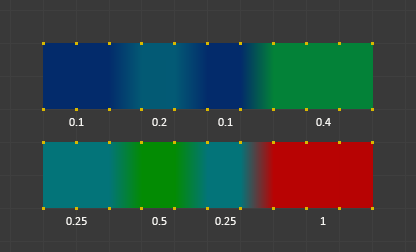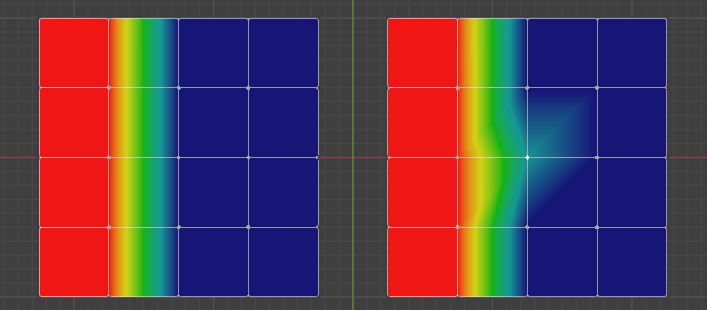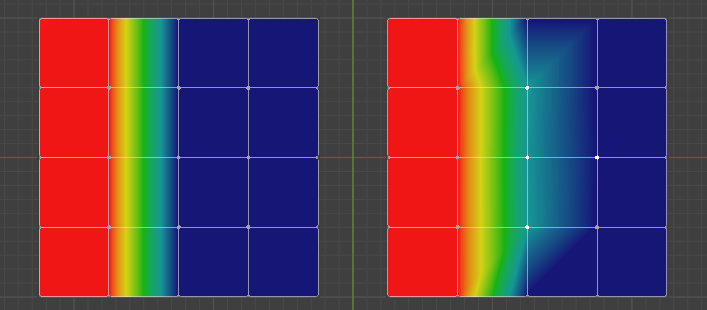Edición¶
Referencia
- Modo:
Modos Edición y Pintar Influencias
- Menú:

Herramientas para Pintar Influencias.¶
Blender proporcionará un conjunto de herramientas utilitarias para pintar influencias.
La opción Subconjunto
Algunas de estas herramientas también proporcionarán un filtro de Subconjunto que permitirá restringir su funcionalidad sólo a ciertos grupos de vértices específicos (en el panel Ajustar última operación, que se muestra después de invocar a la herramienta) con las siguientes opciones:
Grupo activo
Huesos de pose seleccionados
Huesos de pose deformantes
Todos los grupos
All tools also work with Vertex Selection Masking and Face Selection Masking. In these modes the tools operate only on selected vertices or faces.
Asignar desde envolventes de huesos¶
Apply the envelope weight of the selected bone(s) to the selected vertex group.
Asignar autom. desde huesos¶
Apply from the selected bone(s) to the vertex group the same «auto-weighting» methods as available in the Parent armature menu.
Normalizar todo¶
For each vertex, this tool makes sure that the sum of the weights across all vertex groups is equal to 1. This tool normalizes all of the vertex groups, except for locked groups, which keep their weight values untouched.
- Bloquear activo
Keep the values of the active group while normalizing all the others.
Normalizar¶
This tool only works on the active vertex group. All vertices keep their relative weights, but the entire set of weights is scaled up such that the highest weight value is 1.0.

Ejemplo de Normalizar.¶
Voltear¶
The Mirror Vertex Group tool mirrors the weights from one side of a perfectly symmetrical mesh to the opposite side. Those vertices that have no corresponding vertex on the other side will not be affected. But note, the weights are not transferred to the corresponding opposite bone weight group.
Nota
Mirroring only works when the object’s rest pose is perfectly symmetrical across the X axis.

Ejemplo de simetría.¶
- Simetrizar influencias
With this option checked, every selected vertex receives the weight information of its symmetrical counterpart. If both vertices are selected, it will be a weight information exchange; if only one is selected, information from the unselected will overwrite the selected one. Information on weight is passed for the active group only, unless All Groups is checked, in which case it is passed for all groups.
- Invertir nombres de grupos
Works with selected vertices that belong to vertex groups with «symmetrical names» (with components like «L», «R», «right», «left»). All selected vertices that belong to the active group, or to the symmetrical of the active group, will have their assignation to that group replaced by an assignation to the symmetrical one; however, its weight will be preserved. If All Groups is checked, all assignations to these kind of groups will be replaced by the symmetrical counterpart, also keeping the old weights.
- Todos los grupos
Operate on all vertex groups, instead of the active one.
- Simetría topológica
Mirror for meshes which are not fully symmetric (approximate mirror). See here for more information.
Truco
Simetrizar al hueso opuesto
If you want to create a mirrored weight group for the opposite bone (of a symmetric character), then you can do this:
Delete the target vertex group (where the mirrored weights will be placed).
Create a copy of the source bone vertex group (the group containing the weights which you want to copy).
Rename the new vertex group to the name of the target vertex group (the group you deleted above).
Select the target vertex group and call the Mirror tool (use only Mirror Weights and optionally Topology Mirror if your mesh is not symmetric).
Invertir¶
Replaces each Weight of the selected weight group by × -1.0 weight.
Ejemplos:
Original 1.0 converts to 0.0
Original 0.5 remains 0.5
Original 0.0 converts to 1.0

Invertir.¶
- Subconjunto
Restrict the tool to a subset. See above The Subset Option about how subsets are defined.
- Agregar influencias
Add vertices that have no weight before inverting (these weights will all be set to 1.0).
- Eliminar influencias
Remove vertices from the vertex group if they are 0.0 after inverting.
Nota
Locked vertex groups are not affected.
Limpiar¶
Eliminar influencias del grupo de vértices anula la asignación de vértices de grupos de vértices cuyas influencias están por debajo del Límite. Elimina las influencias por debajo de un umbral dado. Esta herramienta es útil para limpiar sus grupos de influencia de influencias muy bajas (o cero).
En el ejemplo mostrado, se utiliza un valor de corte de 0.2 (ver las opciones del operador a continuación) para que se limpien todas las piezas azules.
Tener en cuenta que las imágenes tienen la opción Mostrar influencias nulas activa, para que las influencias sin referencia se muestren en negro.

Ejemplo de Limpiar.¶
- Subconjunto
Restrinja la herramienta a un subconjunto. Consulte más arriba La Opción Subconjunto para saber cómo se definen los subconjuntos.
- Limitar
Este es el valor de influencia mínima que se mantendrá en el grupo. Las influencias por debajo de este valor serán eliminadas del grupo.
- Mantener uno
Ensure that the Clean tool will not create completely unreferenced vertices (vertices which are not assigned to any vertex group), so each vertex will keep at least one weight, even if it is below the limit value!
Cuantizar¶
This operator uses a process known as Quantization which takes the input weights and clamps each weight to a number of steps between (0 - 1), so there is no longer a smooth gradient between values.

Quantize example (Steps = 2).¶
- Intervalos
The number of steps between 0 and 1 to quantize the weights into. For example 5 would allow the following weights
[0.0, 0.2, 0.4, 0.6, 0.8, 1.0].
Niveles¶
Adds an offset and a scale to all weights of the selected weight groups. with this tool you can raise or lower the overall «heat» of the weight group.
Nota
No weight will ever be set to values above 1.0 or below 0.0 regardless of the settings.

Ejemplo de Niveles.¶
- Subconjunto
Restrinja la herramienta a un subconjunto. Consulte más arriba La Opción Subconjunto para saber cómo se definen los subconjuntos.
- Desplazamiento
A value from the range (-1.0 - 1.0) to be added to all weights in the vertex group.
- Ganancia
All weights in the Subset are multiplied with the gain.
Nota
Whichever Gain and Offset you choose, in all cases the final value of each weight will be clamped to the range (0.0 - 1.0). So you will never get negative weights or overheated areas (weight > 1.0) with this tool.
Suavizado¶
The Smooth operator blends the weights of selected vertices based on the average of adjacent vertices, creating smoother transitions in weight painting. This operator is useful for refining weight distributions, improving deformation in rigging, and eliminating abrupt transitions between vertex weights.
Nota
This operator requires vertex selection to be enabled; otherwise, it will be unavailable.
- Subconjunto
Restrict the tool to a subset. See above The Subset Option about how subsets are defined.
- Factor
Controls the amount of blending toward the average weight of connected vertices.
A Factor of 0.0 preserves the original weights.
A Factor of 1.0 fully adopts the calculated average weight.
Values between 0.0 and 1.0 blend the weights proportionally.
- Iteraciones
Sets how many times the smoothing operation is repeated. Higher values produce smoother results but may introduce unwanted artifacts in fine details.
- Expandir / Contraer
Adjusts the smoothing influence by expanding or contracting the selection:
Valores positivos expandirán la selección para incluir a los vértices adyacentes.
Negative values contract the selection to focus on a smaller subset of vertices.
Ejemplos¶
Ejemplo: Vértice individual seleccionado
Consider a single selected vertex connected to four unselected vertices.
The unselected vertices have weights: 1, 0, 0, and 0.
The average weight of the unselected vertices is:
Si el Factor es:
0.0: The selected vertex retains its original weight.
1.0: The selected vertex adopts the calculated average weight (0.25).
Between 0 and 1: The vertex’s weight gradually shifts toward 0.25, blending proportionally.

Vértice individual seleccionado con un Factor de 1.0.¶
Ejemplo: Varios vértices seleccionados
When multiple vertices are selected, the Smooth operator applies calculations to each vertex based on its adjacent unselected vertices.
Por ejemplo:
A vertex connected to three unselected vertices with weights
A vertex connected to one unselected vertex with weight 1 averages to
A vertex connected only to unselected vertices with weights
Estos resultados fundidos dependerán del valor del Factor.

Tres vértices seleccionados con un Factor de 1.0.¶
Ejemplo: Suavizado de bucle de bordes
In a practical use case, selecting a middle edge loop allows the operator to blend weights between adjacent areas. For example:
The edge loop has two unselected adjacent vertices on either side, with weights
The average weight is
Applying the Smooth operator with Factor set to 1.0 will turn the edge loop green, creating a smooth blend between the «hot» (left) and «cold» (right) sides.

Center edge loop of vertices selected with a Factor of 1.0.¶
Transferir influencias¶
Permitirá copiar las influencias desde otros objetos hacia los grupos de vértices del objeto activo.
By default this tool copies only the active (selected) vertex group of the source object to the active vertex group of target object or creates a new one if the group does not exist. However, you can change the tool’s behavior in the Ajustar última operación panel.
For example, to transfer all existing vertex groups from the source objects to the target, change the Source Layers Selection option to By Name.
Nota
This tool uses the generic «data transfer», but transfers from all selected objects to active one. Please refer to the Data Transfer docs for options details and explanations.
Preparación de la copia¶
You first select all source objects, and finally the target object (the target object must be the active object).
It is important that the source objects and the target object are at the same location. If they are placed side-by-side, then the weight transfer will not work. (See the Vertex Mapping option.) You can place the objects on different layers, but you have to ensure that all objects are visible when you call the tool.
Now ensure that the target object is in Weight Paint Mode. Open the Toolbar and call the Transfer Weights tool in the Weight Tools panel.
Confusión con el panel Ajustar última operación¶
You may notice that the Ajustar última operación panel stays available after the weight transfer is done. The panel only disappears when you call another Operator that has its own Ajustar última operación panel. This can lead to confusion when you use Transfer weights repeatedly after you changed your vertex groups. If you then use the still-visible Ajustar última operación panel, then Blender will reset your work to its state right before you initially called the Transfer Weights tool.
So when you want to call the Transfer Weights tool again after you made some changes to your vertex groups, then always use the Transfer Weights button, even if the Ajustar última operación panel is still available. Unless you really want to reset your changes to the initial call of the tool.
Limitar total¶
Reduce el número de grupos de influencia por vértice al límite especificado. La herramienta elimina primero las influencias más bajas hasta alcanzar el límite.
Consejo
La herramienta sólo puede funcionar razonablemente cuando se selecciona más de un grupo de influencia.
- Subconjunto
Restrinja la herramienta a un subconjunto. Consulte más arriba La Opción Subconjunto para saber cómo se definen los subconjuntos.
- Limitar
Número máximo de influencias permitidas en cada vértice.
Definir influencia¶
Referencia
- Modo:
Modo Pintar Influencias
- Menú:
- Atajo:
Ctrl-X
Rellenará el grupo de vértices activo con el valor actual de influencia del pincel.
Tomar muestra (influencia)¶
Referencia
- Modo:
Modo Pintar Influencias
- Menú:
- Atajo:
Mayús-X
Adjust the Weight of the Draw tool to the weight of the vertex under the mouse cursor.
Muestrear grupo¶
Referencia
- Modo:
Modo Pintar Influencias
- Menú:
- Atajo:
Mayús-Ctrl-X
Select one of the vertex groups available under current mouse position.
Gradiente (lineal)¶
Referencia
- Modo:
Modo Pintar Influencias
- Menú:
- Atajo:
Mayús-A
Applies a linear weight gradient; this is useful at times when painting gradual changes in weight becomes difficult. Blends the weights of selected vertices with unselected vertices.

Example of the Gradient tool being used with selected vertices.¶
- Influencia
The gradient starts at the current selected weight value, blending out to nothing.
- Intensidad
Lower values can be used so the gradient mixes in with the existing weights (just like with the brush).
- Tipo
La forma del gradiente.
- Lineal:
Create gradient that forms a straight line.
- Radial:
Create gradient that forms a circle.
Gradiente (radial)¶
Referencia
- Modo:
Modo Pintar Influencias
- Menú:
- Atajo:
Mayús-Alt-A
Applies a radial weight gradient; this is useful at times when painting gradual changes in weight becomes difficult. Blends the weights of selected vertices with unselected vertices.
- Influencia
The gradient starts at the current selected weight value, blending out to nothing.
- Intensidad
Lower values can be used so the gradient mixes in with the existing weights (just like with the brush).
- Tipo
La forma del gradiente.
- Lineal:
Create gradient that forms a straight line.
- Radial:
Create gradient that forms a circle.
Bloqueo¶
Referencia
- Modo:
Modos Edición y Pintar Influencias
- Menú:
- Atajo:
K
Vertex groups can be locked to prevent undesired edits to a particular vertex group.
Truco
Los huesos que pertenezcan a un grupo de vértices bloqueado serán mostrados en rojo en la Vista 3D.
- Bloquear todo
Locks all vertex groups.
- Bloquear lo seleccionado
Locks selected vertex groups.
- Bloquear no seleccionados
Locks unselected vertex groups.
- Bloquear sólo lo seleccionado
Lock selected and unlock selected vertex groups.
- Bloquear sólo lo no seleccionado
Desbloquea los grupos de vértices seleccionados y bloquea los no seleccionados.
- Desbloquear todo
Unlocks all vertex groups.
- Desbloquear lo seleccionado
Unlocks selected vertex groups.
- Desbloquear lo no seleccionado
Unlocks Unselected vertex groups.
- Invertir bloqueo
Invertirá el estado de bloqueo de todos los grupos de vértices.